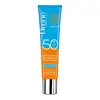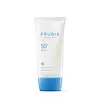What's inside
What's inside
 Key Ingredients
Key Ingredients

 Benefits
Benefits

 Concerns
Concerns

 Ingredients Side-by-side
Ingredients Side-by-side

Water
Skin ConditioningEthylhexyl Methoxycinnamate
UV AbsorberDibutyl Adipate
EmollientCaprylic/Capric Triglyceride
MaskingGlyceryl Stearate
EmollientGlycerin
HumectantMethylene Bis-Benzotriazolyl Tetramethylbutylphenol
UV FilterCetearyl Alcohol
EmollientPEG-100 Stearate
Butyl Methoxydibenzoylmethane
UV Absorber1,2-Hexanediol
Skin ConditioningDiethylamino Hydroxybenzoyl Hexyl Benzoate
UV FilterDimethicone
EmollientGalactoarabinan
Bis-Ethylhexyloxyphenol Methoxyphenyl Triazine
Skin ConditioningAcrylates/C12-22 Alkyl Methacrylate Copolymer
Ethylhexyl Triazone
UV AbsorberHydroxyacetophenone
AntioxidantXanthan Gum
EmulsifyingDecyl Glucoside
CleansingTocopheryl Acetate
AntioxidantArginine
MaskingAllantoin
Skin ConditioningDisodium EDTA
Coco-Glucoside
CleansingCitric Acid
BufferingDisodium Lauryl Sulfosuccinate
CleansingPropylene Glycol
HumectantLaminaria Ochroleuca Extract
Skin ConditioningWater, Ethylhexyl Methoxycinnamate, Dibutyl Adipate, Caprylic/Capric Triglyceride, Glyceryl Stearate, Glycerin, Methylene Bis-Benzotriazolyl Tetramethylbutylphenol, Cetearyl Alcohol, PEG-100 Stearate, Butyl Methoxydibenzoylmethane, 1,2-Hexanediol, Diethylamino Hydroxybenzoyl Hexyl Benzoate, Dimethicone, Galactoarabinan, Bis-Ethylhexyloxyphenol Methoxyphenyl Triazine, Acrylates/C12-22 Alkyl Methacrylate Copolymer, Ethylhexyl Triazone, Hydroxyacetophenone, Xanthan Gum, Decyl Glucoside, Tocopheryl Acetate, Arginine, Allantoin, Disodium EDTA, Coco-Glucoside, Citric Acid, Disodium Lauryl Sulfosuccinate, Propylene Glycol, Laminaria Ochroleuca Extract
Water
Skin ConditioningPropanediol
SolventEthylhexyl Methoxycinnamate
UV AbsorberDibutyl Adipate
EmollientDiethylamino Hydroxybenzoyl Hexyl Benzoate
UV FilterC12-15 Alkyl Benzoate
AntimicrobialNiacinamide
SmoothingTitanium Dioxide
Cosmetic ColorantPolyglyceryl-2 Stearate
EmulsifyingCetyl Alcohol
EmollientEthylhexyl Triazone
UV AbsorberCyclopentasiloxane
EmollientStearyl Alcohol
EmollientSilica
AbrasiveGlyceryl Stearate
EmollientCetearyl Olivate
Polysorbate 60
EmulsifyingGlyceryl Caprylate
EmollientAluminum Hydroxide
EmollientHydroxyethyl Acrylate/Sodium Acryloyldimethyl Taurate Copolymer
Emulsion StabilisingSorbitan Olivate
EmulsifyingPolyhydroxystearic Acid
EmulsifyingMethicone
EmollientMyristyl Alcohol
EmollientAdenosine
Skin ConditioningSorbitan Isostearate
EmulsifyingLauryl Alcohol
EmollientSodium Hyaluronate
HumectantVaccinium Angustifolium Fruit Extract
Skin ProtectingButylene Glycol
HumectantMalpighia Emarginata Fruit Extract
Skin ConditioningCoco-Caprylate/Caprate
EmollientVitis Vinifera Seed Oil
EmollientPrunus Armeniaca Kernel Oil
MaskingPropylene Glycol
HumectantBiosaccharide Gum-4
Skin ConditioningSalix Alba Bark Extract
AstringentOriganum Vulgare Leaf Extract
Skin ConditioningMangifera Indica Fruit Extract
Skin ConditioningHyaluronic Acid
HumectantGarcinia Mangostana Peel Extract
Skin ConditioningChamaecyparis Obtusa Leaf Extract
Skin ConditioningSolanum Lycopersicum Seed Oil
EmollientScutellaria Baicalensis Root Extract
AstringentPunica Granatum Seed Oil
EmollientPortulaca Oleracea Extract
Skin ConditioningMangifera Indica Seed Oil
EmollientLactobacillus/Soybean Ferment Extract
Skin ConditioningCitrus Paradisi Seed Oil
PerfumingCinnamomum Cassia Bark Extract
MaskingTocopherol
AntioxidantTocopheryl Acetate
AntioxidantDisodium EDTA
Ethylhexylglycerin
Skin Conditioning1,2-Hexanediol
Skin ConditioningPhenoxyethanol
PreservativeChlorphenesin
AntimicrobialParfum
MaskingWater, Propanediol, Ethylhexyl Methoxycinnamate, Dibutyl Adipate, Diethylamino Hydroxybenzoyl Hexyl Benzoate, C12-15 Alkyl Benzoate, Niacinamide, Titanium Dioxide, Polyglyceryl-2 Stearate, Cetyl Alcohol, Ethylhexyl Triazone, Cyclopentasiloxane, Stearyl Alcohol, Silica, Glyceryl Stearate, Cetearyl Olivate, Polysorbate 60, Glyceryl Caprylate, Aluminum Hydroxide, Hydroxyethyl Acrylate/Sodium Acryloyldimethyl Taurate Copolymer, Sorbitan Olivate, Polyhydroxystearic Acid, Methicone, Myristyl Alcohol, Adenosine, Sorbitan Isostearate, Lauryl Alcohol, Sodium Hyaluronate, Vaccinium Angustifolium Fruit Extract, Butylene Glycol, Malpighia Emarginata Fruit Extract, Coco-Caprylate/Caprate, Vitis Vinifera Seed Oil, Prunus Armeniaca Kernel Oil, Propylene Glycol, Biosaccharide Gum-4, Salix Alba Bark Extract, Origanum Vulgare Leaf Extract, Mangifera Indica Fruit Extract, Hyaluronic Acid, Garcinia Mangostana Peel Extract, Chamaecyparis Obtusa Leaf Extract, Solanum Lycopersicum Seed Oil, Scutellaria Baicalensis Root Extract, Punica Granatum Seed Oil, Portulaca Oleracea Extract, Mangifera Indica Seed Oil, Lactobacillus/Soybean Ferment Extract, Citrus Paradisi Seed Oil, Cinnamomum Cassia Bark Extract, Tocopherol, Tocopheryl Acetate, Disodium EDTA, Ethylhexylglycerin, 1,2-Hexanediol, Phenoxyethanol, Chlorphenesin, Parfum
 Reviews
Reviews

Ingredients Explained
These ingredients are found in both products.
Ingredients higher up in an ingredient list are typically present in a larger amount.
1,2-Hexanediol is a synthetic liquid and another multi-functional powerhouse.
It is a:
- Humectant, drawing moisture into the skin
- Emollient, helping to soften skin
- Solvent, dispersing and stabilizing formulas
- Preservative booster, enhancing the antimicrobial activity of other preservatives
Dibutyl Adipate is an emollient and solvent. It is created from butyl alcohol and adipic acid.
As a solvent, Dibutyl Adipate helps mix and disperse ingredients evenly.
Dibutyl Adipate is soluble in water and organic solvents. It does not absorb UV rays.
Learn more about Dibutyl AdipateDiethylamino Hydroxybenzoyl Hexyl Benzoate (DHHB) is a chemical UV-A absorber. It is formulated for high UVA protection (320-400 nm).
DHHB is well-liked for:
DHHB has been approved by the EU, Japan, Taiwan, and South America for use up to 10%. Unfortunately, it has not been approved for use in the US or Canada due to slow regulatory processes.
This ingredient is soluble in oils, fats, and lipids.
Learn more about Diethylamino Hydroxybenzoyl Hexyl BenzoateDisodium EDTA plays a role in making products more stable by aiding other preservatives.
It is a chelating agent, meaning it neutralizes metal ions that may be found in a product.
Disodium EDTA is a salt of edetic acid and is found to be safe in cosmetic ingredients.
Learn more about Disodium EDTAEthylhexyl Methoxycinnamate is an organic compound that provides UVB protection. It often goes by the more common name of octinoxate. It is created from methoxycinnamic acid and 2-ethylhexanol.
Ethylhexyl Methoxycinnamate absorbs UVB rays with wavelengths between 280-320 nm. UV absorbers protect your skin by using chemical reactions to convert UV rays into heat and energy.
UVB (290-320 nm) rays emit more energy than UVA rays. They are capable of damaging DNA, causing sunburns and are thought to be linked to skin cancer.
The state of Hawaii has banned sunscreens containing octinoxate due to its potential impact on coral reefs. More research is needed to bridge gaps in this research. The European Union allows higher levels of octinoxate in sunscreens than the US and Australia.
Ethylhexyl Methoxycinnamate is oil soluble. It is not stable and may lose efficacy when exposed to sunlight.
Learn more about Ethylhexyl MethoxycinnamateEthylhexyl Triazone is a modern chemical sunscreen that protects from UV-B radiation.
It is the most effective of existing UV-B filters, as it provides the highest level of photo-stable absorption. It protects from the entire UV-B range (280 to 320nm), with it's highest level of protection at 314nm.
Ethylhexyl Triazone is oil soluble, oderless and colorless, which mean it is able to be incorporated into a variety of different formulations.
It is not currently available within the United States due to slow changing FDA regulations. Outside of the US, it is used in formulations at concentrations up to 5%.
Learn more about Ethylhexyl TriazoneGlyceryl Stearate is a mix of glycerin and stearic acid.
It is used to stabilize the mixing of water and oil ingredients. By preventing these ingredients from separating, it can help elongate shelf life. It can also help thicken the product's texture.
As an emollient, it helps soften skin and supports barrier-replenishing ingredients.
In cosmetics, Glyceryl Stearate is often made from vegetable oils or synthetically produced.
This ingredient may not be fungal-acne safe
Fun fact: The human body also creates Glyceryl Stearate naturally.
Learn more about Glyceryl StearatePropylene Glycol is an odorless, colorless liquid. As a humectant, it helps skin retain moisture. It also aids in delivering active ingredients.
Another role of this ingredient is preventing a product from melting or freezing. Propylene glycol also adds antimicrobrial properties to a product, elongating product lifespan.
This ingredient is considered an organic alcohol and commonly added into both cosmetics and foods.
Those with sensitive skin or conditions may develop a rash when using this ingredient.
Learn more about Propylene GlycolTocopheryl Acetate is AKA Vitamin E. It is an antioxidant and protects your skin from free radicals. Free radicals damage the skin by breaking down collagen.
One study found using Tocopheryl Acetate with Vitamin C decreased the number of sunburned cells.
Tocopheryl Acetate is commonly found in both skincare and dietary supplements.
Learn more about Tocopheryl AcetateWater. It's the most common cosmetic ingredient of all. You'll usually see it at the top of ingredient lists, meaning that it makes up the largest part of the product.
So why is it so popular? Water most often acts as a solvent - this means that it helps dissolve other ingredients into the formulation.
You'll also recognize water as that liquid we all need to stay alive. If you see this, drink a glass of water. Stay hydrated!
Learn more about Water